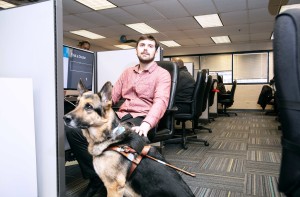Sandy’s View: Sandy’s Top Five Tips for Working and Interacting with Colleagues who have Disabilities
Today, many businesses are becoming more inclusive of individuals with all types of disabilities. I have been blind most of my life and applaud this effort. Because of it, more people with disabilities are integrated into the workforce and community at large. Still, it is not uncommon for able-bodied individuals to be hesitant about interacting or getting to know me. I understand their hesitation. After all, chances are that this is their first time meeting someone who is blind, and they do not want to do something that might be offensive or out of place. Truth is, we want and should be treated like everyone else, but there are a few helpful suggestions and considerations that can go a long way. This week, I am sharing my top five tips for interacting with people with disabilities in the workplace and beyond.
Tip#1: Never pet or feed service animals while they are working!
Many of us have been tempted or even guilty of interacting with a service animal when we see one. Keep in mind that these specially trained animals are also working and should not be distracted. Unless its owner says it is ok, never talk to, pet or feed a guide dog or other service animal.

Service animals, such as guide dogs, have an important job assisting individuals who are blind or visually impaired. Although tempting, never pet, feed or distract a service animal while it is working!
Tip #2: Avoid moving or manipulating assistive devices.
Canes, crutches, wheelchairs or other assistive tools are instrumental to people with disabilities because they allow us to be independent and safe. To that end, you should not move or grab them. Of course, there might be times when you have to move a device out of the way. That is perfectly acceptable, but make sure to let the person know first and leave the tool back where you found it.
Tip #3: Try to consider things that might be helpful to us.
As someone with vision loss, I certainly do not expect my colleagues to read my mind and know what I need or want. That being said, it is appreciated when a co-worker is thoughtful. If you have a colleague who is severely visually impaired, emailing him or her any handouts before a meeting can be beneficial. When you are going to lunch at a restaurant with someone who uses a wheelchair, taking the time to verify that the location is wheelchair accessible will be greatly appreciated. Simple considerations can go a long way!
Tip #4: Ask how you can help!
If you are simply not sure if or how to assist a co-worker who is disabled, just ask! We are the ‘experts’ on what works and doesn’t work for our given circumstances. Similarly, if we refuse the help, please do not be offended. We appreciate the offer, but assistance might not be needed.
Tip #5: Treat us like anyone else!
This is the most important word of advice. Remember that as individuals with disabilities, we are people first. We have hobbies, interests, likes, dislikes and so on just like you. Similarly, do not be afraid to include us in events or gatherings outside of work. What better way to get to know each other than by going out for coffee or dinner! If you get to know us, you will realize just how much we all have in common!
It is completely normal for non-disabled individuals to feel hesitant when meeting or interacting with a person who has a disability for the first time, but it does not have to be that way. I hope these tips will help you think about some simple considerations the next time you have a colleague with a disability at your workplace. Are you currently working and would like to share other tips? I would love to hear from you! Leave a comment on this post, or email me at sandysview@chicagolighthouse.org.





